

Crazyfads.com - Crazy Fads. Top 50 Australian Pop Culture Icons: Film, TV, Music & More. Freedom Rides - Black History. My TV provider is not listed.
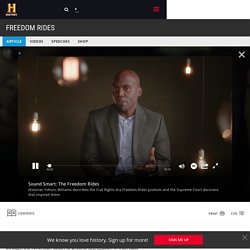
Why not? We are currently working on adding more TV providers. Please check back frequently to see if your TV provider has been added. Why do I need to log in to watch some video content? Viewers who verify their subscription to a TV provider get access to a deeper catalog of video content, including more full episodes. I am able to watch on TV. This service is only available through participating TV providers.
How much does it cost to access all of the video content? Accessing video content is free, however, you will need to verify your TV provider subscription by logging in in order to access all of our video content. Can I watch videos if my TV provider isn't currently supported? Yes! What kind of programming is available if I log in? You will get access to more full episodes than ever before. How often is new video added to the website? There will be new episodes and web exclusives added every day. How quickly does a new episode get added after it airs on TV? How Aboriginal activism brought change.
IT WAS BUT HALF a century ago, a time still sharp in the minds of a baby boomer generation, that landmark battles were waged and won by Aboriginal people, for Aboriginal people.
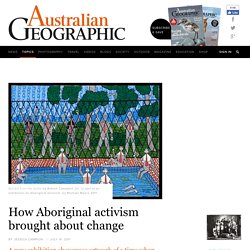
In the 1960s, Aboriginal people achieved citizenship, financial assistance, and equal pay, and won back rights to their land and rights to the preservation of their cultural heritage. "The 60s was the most important era for Aboriginal people," says Noeline Briggs-Smith, Aboriginal historian and educator. Australian Institute of Aboriginal and Torres Strait Islander Studies. The students that made up SAFA came from many different existing societies including the Australian Labor Party (ALP), the Newman society, the Jewish Students Union and the Civil Liberties Association.
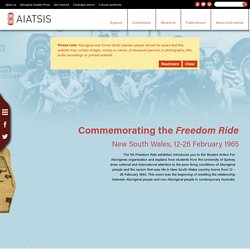
Led by Charles Perkins there were around 35 students that took part in the Freedom Ride. Note: Ages are sometimes approximate, and both age and enrolment in university courses are for February 1965. What is the Universal Declaration of Human Rights? Back to Universal Declaration of Human Rights Anniversary pages The Universal Declaration of Human Rights (Universal Declaration) is an international document that states basic rights and fundamental freedoms to which all human beings are entitled.
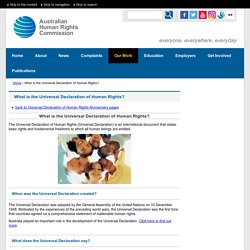
Transport in Australia timeline. Technology in Australia 1788-1988, Chapter 7, page 435. The First 100 Years 1788-1888 The arrival of the First Fleet in 1788 represents the beginning of the history of transport in Australia.
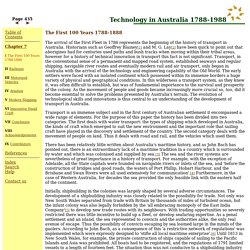
Historians such as Geoffrey Blainey[1] and M. G. Lay[2] have been quick to point out that aborigines had for centuries used paths and bush tracks when moving within their tribal areas, however for a history of technical innovation in transport this fact is not significant. The Snowy Mountains Scheme. Jounama Dam.
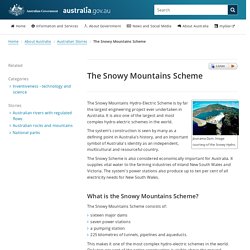
Image courtesy of the Snowy Hydro. The Snowy Mountains Hydro-Electric Scheme is by far the largest engineering project ever undertaken in Australia. The History. On completion in 1974, the Scheme consisted of seven power stations, 16 major dams, 145 kilometres of inter-connected tunnels and 80 kilometres of aqueducts.
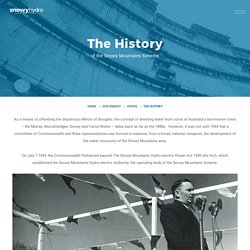
In 1997 a new company, Snowy Hydro Trading Pty Ltd (SHTPL), was established by the New South Wales Government and the State Electricity Commission of Victoria, as a joint venture to trade electricity generated by the Snowy Mountains Scheme in the National Electricity Market. ABC History. Introduction Launched in 1932, the ABC has become a much loved part of the Australian society and its cultural fabric.
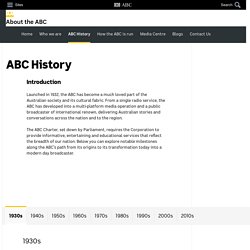
From a single radio service, the ABC has developed into a multi-platform media operation and a public broadcaster of international renown, delivering Australian stories and conversations across the nation and to the region. The ABC Charter, set down by Parliament, requires the Corporation to provide informative, entertaining and educational services that reflect the breadth of our nation. Below you can explore notable milestones along the ABC’s path from its origins to its transformation today into a modern day broadcaster. 1930s The Australian Broadcasting Commission (the ABC) was officially launched on 1 July, 1932 by Prime Minister Joseph Lyons and ABC radio announcer Conrad Charlton.
Headlines Through History - History (6) Newspaper Home. Nuclear weapons timeline. The push for nuclear weapons in Australia 1950s-1970s. This article addresses the support in Australia during the 1950s and 60s for the manufacture or acquisition of nuclear weapons.
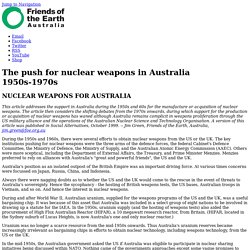
The article then considers the shifting debates from the 1970s onwards, during which support for the production or acquisition of nuclear weapons has waned although Australia remains complicit in weapons proliferation through the US military alliance and the operations of the Australian Nuclear Science and Technology Organisation. A version of this article was published in Social Alternatives, October 1999. -- Jim Green, Friends of the Earth, Australia, jim.green@foe.org.au. A–Z for researchers – National Archives of Australia, Australian Government. Australian Mothers of War Brides Goodwill Mission Club, 1950 (NAA: A8139, VOLUME 8) As a result of Australian involvement in various wars over the last century, there were a number of marriages among Australian servicemen and women from countries where they were serving.
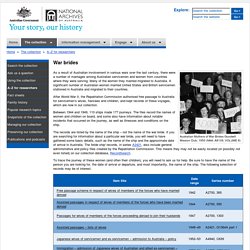
Many of the women they married migrated to Australia. A significant number of Australian women married United States and British servicemen stationed in Australia and migrated to their countries. Baby boomers. With the end of World War II in 1945 Australia's servicemen and women returned and family life resumed after an interruption of almost six years of wartime conflict. Nine months later saw the start of a population revolution as childbirth rates soared – more than four million Australians were born between 1946–1961. People born during this period became known as baby boomers. Our passion for consumption keeps the wheels of history turning.
By Carlos Lozada There are lots of books about a single thing that supposedly changed everything. They all sound the same, with titles like Cod: A Biography of the Fish That Changed the World or Tea: The Drink That Changed the World or The Box: How the Shipping Container Made the World Smaller and the World Economy Bigger. They're all true, to a point, but all exaggerated, magnifying the influence of one item or product to tell a bigger story.
Frank Trentmann, a historian at Birkbeck College, University of London, takes this model and flips it: He has written a book about everything in order to illuminate the story of individual daily life. Post–World War II: 1946–60 - Fashion, Costume, and Culture: Clothing, Headwear, Body Decorations, and Footwear through the Ages. The world woke up from a six-year-long nightmare in the summer of 1945. World War II (1939–45), which had pitted the Allied forces of the United States, Britain, France, Russia, Canada, Australia, and other nations against the Axis forces of Germany, Japan, Italy, Austria, and others, finally ended, but the effects of the war lingered on for years afterward. The economies of Europe and Japan were in ruins, and people around the world struggled to recover from the deadliest war in human history.
Yet over the next fifteen years, the world did recover. Led by the United States, the economies of the world expanded and people in the West enjoyed new access to consumer goods. Meanwhile, countries such as the Soviet Union and China embraced a radical form of government known as communism. Postwar politics Changes in world politics proved to be very important in the years after World War II.
During the war, but that friendship would not last for long. Fact Sheet – More than 65 Years of Post-war Migration. On this page The Department has facilitated the permanent migration of more than seven million people since its establishment in 1945. The contribution of migrants to Australian society, culture and prosperity has been an important factor in shaping our nation. A large-scale program of migration to Australia began at the end of World War II when millions of people in Europe were displaced from their homelands.
During this time in Australia, there was a desperate shortage of labour and a growing belief that substantial population growth was essential for the country's future. Untitled. She's Game: Women Making Australian Sporting History - Home. She's Game: Women Making Australian Sporting History highlights the achievements of Australian women who have contributed to Australian sporting life and culture. Athletes, coaches, administrators, journalists and volunteers are recognised for the important roles they have played in Australian sporting history. Some of the people in the stories are elite athletes who became sporting heroines and household names, but many of the stories are about women whose achievements have been hitherto overlooked.
Bringing these lesser known stories to light became our research priority. Short historical notes, entered into a searchable database linked to this exhibition, have been prepared for over 100 women, teams and organisations. Some contain links to further bibliographical and archival resources. Aboriginal history timeline (1970 - 1999) - Creative Spirits. 1972 Self-determination (self-management) policyJanuary - July: The Aboriginal Tent Embassy is pitched outside Parliament House in Canberra, demonstrating for land rights.14 July: On National Aborigines Day there are Australia wide strikes and marches by Aboriginal people.23 August: NSW Director-General of Education approved the removal of the section of the teachers’ handbook that allowed school principals to refuse enrolment to Aboriginal children because of home conditions or substantial opposition from the community.Aboriginal Heritage Protection Act is proclaimed in Western Australia.The Whitlam (Labor) government abolishes the White Australia Policy and introduces a policy of self-determination.
Timeline: Indigenous rights movement. American and British cultural influence, Social and cultural features of the 1960s, Australia's social and cultural history in the post-war period, History Year 9, NSW. British influence on the Australian culture. Highlights in Australian theatre history. The 1975 Dismissal · Dismissed! at the Museum of Australian Democracy. The Dismissal of the Whitlam Government - November 11th, 1975. Korean War, 1950-53. Australia's involvement in the Korean War. Australian music. Peter van Velthoven, Didgeridoo player from the band Yothu Yindi. Photograph courtesy of Peter van Velthoven. Australia's migration history timeline. Australia wants, and will welcome, new healthy citizens who are determined to become good Australians.Arthur Caldwell, Australian Minister for Immigration, 1945 British migrants arrive in Sydney on the Fairsea, c.1963. Post World War II British Migration to Australia. Summary. ABC online education.
Transcript. Families and cultural diversity in Australia - 1. Families, values and change: Setting the scene. By Robyn Hartley Australia has a unique history, important elements of which are an indigenous population, a British colonial past and recent exten- sive immigration of people from many different countries and cultures. ABC online education. Text Womens Changing Rights. Timeline: the women's movement. History and successes : AIS : Australian Sports Commission. History of Australian Sport - Main Contents. A sporting nation. History of Shopping and Advertising in Australia - Overnights - ABC Radio. All advertisements on ASO - Australia's audio and visual heritage online. The Sell: 200 years of advertising history on show at National Library of Australia. The changing face of modern Australia – 1950s to 1970s.
Strike a Pose. Modern Australian fashion. Australia.gov.au - NLA Australian Government Web Archive. Record - Vrroom. Film in Australia. Industry trends - Cinema - Fact Finders - Screen Australia. The Olympic Games come to Australia - 80 Days That Changed Our Lives - ABC Archives. Australian Olympic Committee: Melbourne 1956. National Museum of Australia. Queen Elizabeth II visits Australia - 80 Days That Changed Our Lives - ABC Archives.
The first presidential visit to Australia. Lyndon B. Johnson's 1966 Tour Of Australia Photos and Images. Australia's untold reaction to the Cuban Missile Crisis. What's the crisis in the Cuban Missile Crisis?